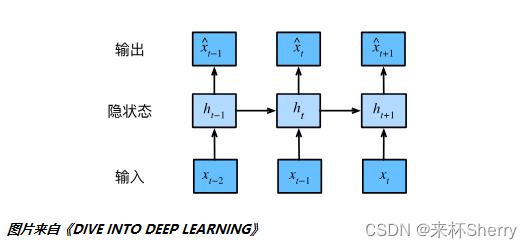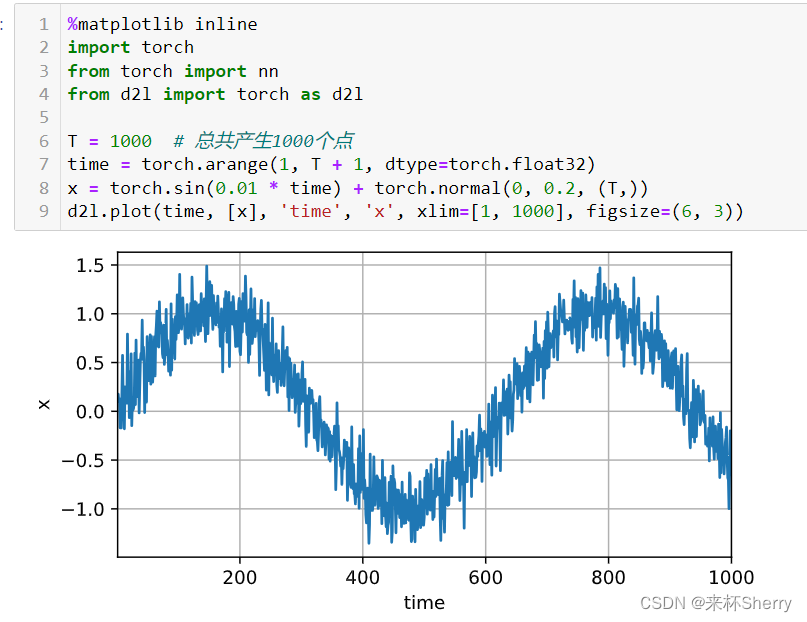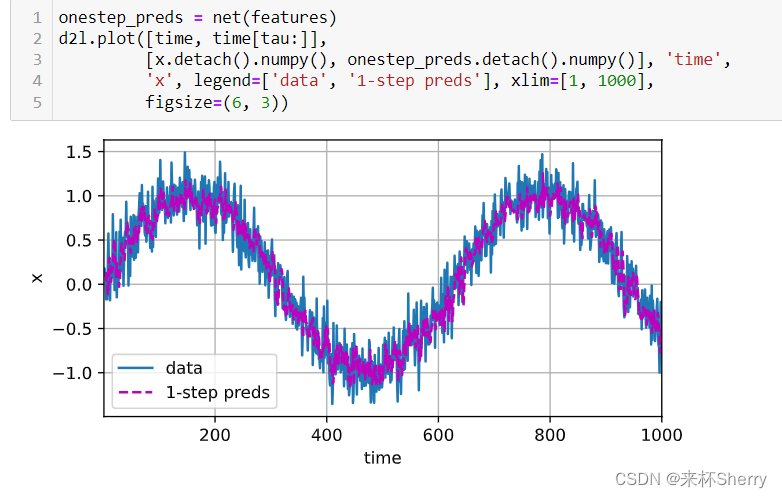循环神经网络——上篇【深度学习】【PyTorch】【d2l】
循环神经网络——上篇【深度学习】【PyTorch】【d2l】

来杯Sherry
发布于 2023-09-19 10:21:49
发布于 2023-09-19 10:21:49
6、循环神经网络
6.1、序列模型
6.1.1、序列模型
序列模型主要用于处理具有时序结构的数据, **时序数据是连续的,**随着时间的推移,如电影评分、电影奖项、电影导演演员等。
反序推测
从未来去推前面发生什么,物理上不一定可行。
6.1.2、条件概率建模
公式
对过去的数据建模,使用自身过去数据去预测自身未来数据,称为自回归模型。
建模方案
1)马尔科夫假设
相当长的序列
是不必要的,满足
长度的序列
足够。
2)潜变量模型
引入潜变量
表示过去的信息。

因此,
6.1.2、代码实现
生成类似正弦变换的样本数据
%matplotlib inline
import torch
from torch import nn
from d2l import torch as d2l
T = 1000 # 总共产生1000个点
time = torch.arange(1, T + 1, dtype=torch.float32)
x = torch.sin(0.01 * time) + torch.normal(0, 0.2, (T,))
d2l.plot(time, [x], 'time', 'x', xlim=[1, 1000], figsize=(6, 3))
将这个序列转换为模型的特征-标签对(feature-label)
若没有足够的历史记录来描述前τ个数据样本。 一个简单的解决办法是:如果拥有足够长的序列就丢弃这几项; 另一个方法是用零填充序列。
tau = 4
features = torch.zeros((T - tau, tau))
for i in range(tau):
features[:, i] = x[i: T - tau + i]
labels = x[tau:].reshape((-1, 1))
batch_size, n_train = 16, 600
# 只有前n_train个样本用于训练
train_iter = d2l.load_array((features[:n_train], labels[:n_train]),
batch_size, is_train=True)定义模型
# 初始化网络权重的函数
def init_weights(m):
if type(m) == nn.Linear:
nn.init.xavier_uniform_(m.weight)
# 一个简单的多层感知机
def get_net():
net = nn.Sequential(nn.Linear(4, 10),
nn.ReLU(),
nn.Linear(10, 1))
net.apply(init_weights)
return net
# 平方损失。注意:MSELoss计算平方误差时不带系数1/2
loss = nn.MSELoss(reduction='none')训练
def train(net, train_iter, loss, epochs, lr):
trainer = torch.optim.Adam(net.parameters(), lr)
for epoch in range(epochs):
for X, y in train_iter:
trainer.zero_grad()
l = loss(net(X), y)
l.sum().backward()
trainer.step()
print(f'epoch {epoch + 1}, '
f'loss: {d2l.evaluate_loss(net, train_iter, loss):f}')
net = get_net()
train(net, train_iter, loss, 5, 0.01)epoch 1, loss: 0.063649
epoch 2, loss: 0.060103
epoch 3, loss: 0.056767
epoch 4, loss: 0.056202
epoch 5, loss: 0.054945预测
onestep_preds = net(features)
d2l.plot([time, time[tau:]],
[x.detach().numpy(), onestep_preds.detach().numpy()], 'time',
'x', legend=['data', '1-step preds'], xlim=[1, 1000],
figsize=(6, 3))
6.2、文本预处理
6.2.1、理论部分
解析文本|预处理步骤:
- 将文本作为字符串加载到内存中;
- 将字符串拆分为词元(如单词和字符);
- 建立一个词表,将拆分的词元映射到数字索引;
- 将文本转换为数字索引序列,方便模型操作。
6.2.2、代码实现
import collections
import re
from d2l import torch as d2l步骤一:读取数据集
这里为了简化,忽略了标点符号和字母大写。
#@save
d2l.DATA_HUB['time_machine'] = (d2l.DATA_URL + 'timemachine.txt',
'090b5e7e70c295757f55df93cb0a180b9691891a')
def read_time_machine(): #@save
"""将时间机器数据集加载到文本行的列表中"""
with open(d2l.download('time_machine'), 'r') as f:
lines = f.readlines()
return [re.sub('[^A-Za-z]+', ' ', line).strip().lower() for line in lines]
lines = read_time_machine()
print(f'# 文本总行数: {len(lines)}')
print(lines[0])
print(lines[10])Downloading ..\data\timemachine.txt from http://d2l-data.s3-accelerate.amazonaws.com/timemachine.txt...
# 文本总行数: 3221
the time machine by h g wells
twinkled and his usually pale face was flushed and animated the步骤二:拆分词元
def tokenize(lines, token='word'): #@save
"""将文本行拆分为单词或字符词元"""
if token == 'word':
return [line.split() for line in lines]
elif token == 'char':
return [list(line) for line in lines]
else:
print('错误:未知词元类型:' + token)
tokens = tokenize(lines)
for i in range(11):
print(tokens[i])['the', 'time', 'machine', 'by', 'h', 'g', 'wells']
[]
[]
[]
[]
['i']
[]
[]
['the', 'time', 'traveller', 'for', 'so', 'it', 'will', 'be', 'convenient', 'to', 'speak', 'of', 'him']
['was', 'expounding', 'a', 'recondite', 'matter', 'to', 'us', 'his', 'grey', 'eyes', 'shone', 'and']
['twinkled', 'and', 'his', 'usually', 'pale', 'face', 'was', 'flushed', 'and', 'animated', 'the']步骤三&四:建立词表&转换为数字序列
class Vocab: #@save
"""文本词表"""
def __init__(self, tokens=None, min_freq=0, reserved_tokens=None):
if tokens is None:
tokens = []
if reserved_tokens is None:
reserved_tokens = []
# 按出现频率排序
counter = count_corpus(tokens)
self._token_freqs = sorted(counter.items(), key=lambda x: x[1],
reverse=True)
# 未知词元的索引为0
self.idx_to_token = ['<unk>'] + reserved_tokens
self.token_to_idx = {token: idx
for idx, token in enumerate(self.idx_to_token)}
for token, freq in self._token_freqs:
if freq < min_freq:
break
if token not in self.token_to_idx:
self.idx_to_token.append(token)
self.token_to_idx[token] = len(self.idx_to_token) - 1
def __len__(self):
return len(self.idx_to_token)
def __getitem__(self, tokens):
if not isinstance(tokens, (list, tuple)):
return self.token_to_idx.get(tokens, self.unk)
return [self.__getitem__(token) for token in tokens]
def to_tokens(self, indices):
if not isinstance(indices, (list, tuple)):
return self.idx_to_token[indices]
return [self.idx_to_token[index] for index in indices]
@property
def unk(self): # 未知词元的索引为0
return 0
@property
def token_freqs(self):
return self._token_freqs
def count_corpus(tokens): #@save
"""统计词元的频率"""
# 这里的tokens是1D列表或2D列表
if len(tokens) == 0 or isinstance(tokens[0], list):
# 将词元列表展平成一个列表
tokens = [token for line in tokens for token in line]
return collections.Counter(tokens)打印前10高频词及其索引
vocab = Vocab(tokens)
print(list(vocab.token_to_idx.items())[:10])[('<unk>', 0), ('the', 1), ('i', 2), ('and', 3), ('of', 4), ('a', 5), ('to', 6), ('was', 7), ('in', 8), ('that', 9)]将每行转换成一个数字索引列表(前10个词元列表)
for i in [0, 10]:
print('文本:', tokens[i])
print('索引:', vocab[tokens[i]])功能整合
为了简化,使用字符(而不是单词)实现文本词元化; 时光机器数据集中的每个文本行不一定是一个句子或一个段落,还可能是一个单词,因此返回的
corpus仅处理为单个列表,而不是使用多词元列表构成的一个列表。
def load_corpus_time_machine(max_tokens=-1): #@save
"""返回时光机器数据集的词元索引列表和词表"""
lines = read_time_machine()
tokens = tokenize(lines, 'char')
vocab = Vocab(tokens)
# 因为时光机器数据集中的每个文本行不一定是一个句子或一个段落,
# 所以将所有文本行展平到一个列表中
corpus = [vocab[token] for line in tokens for token in line]
if max_tokens > 0:
corpus = corpus[:max_tokens]
return corpus, vocab
corpus, vocab = load_corpus_time_machine()
len(corpus), len(vocab)(170580, 28)6.3、语言模型和数据集
(待补充)
本文参与 腾讯云自媒体同步曝光计划,分享自作者个人站点/博客。
如有侵权请联系 cloudcommunity@tencent.com 删除
评论
登录后参与评论
推荐阅读
目录

